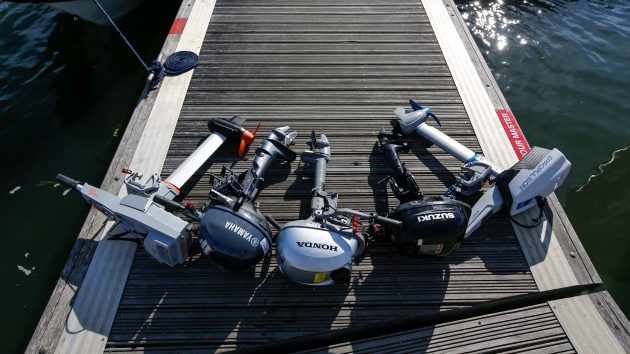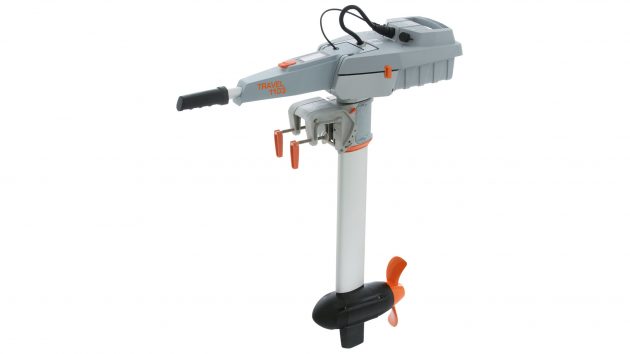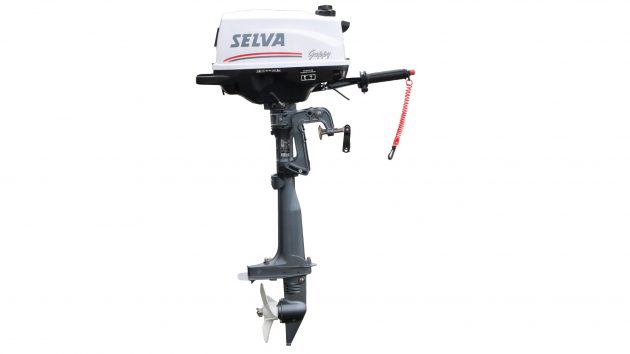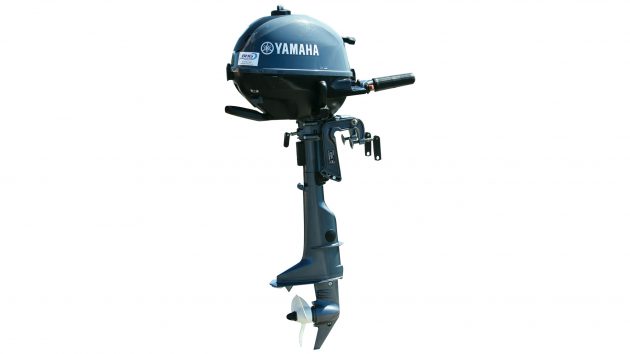Now there are electric outboards as well as petrol motors, the choice of 2-3hp outboard engines has never been better. But which is right for you?
Choosing an outboard engine for your tender used to be as simple as going to your nearest dealer and picking up whatever 2.5hp engine they had in stock. Now, however, things have got a bit more complicated – in a good way, with both petrol and electric outboards providing reasonable options.
First you’ve got to decide whether you are going to stick with petrol or go electric, then there’s the question of who offers the best combination of power, range, weight, build quality, refinement, ease of use and, of course, price.
You could go round and round in circles for hours trying to decide what was right for you. So that’s exactly what we did, on your behalf, by assembling all the main players along with one of F-RIB’s 2.75m folding mini-RIBs to test them on and work out which were the lightest, fastest, most user-friendly engines for your yacht’s tender.
Honda, Suzuki, Yamaha and Selva all provided petrol engines of 2.3-2.5hp for the test while Torqeedo and ePropulsion represented the electric outboards.
Electric outboards
ePropulsion Spirit 1.0 Plus
Chinese company ePropulsion is the (relatively) new electric kid on the block and clearly has its sights set on Torqeedo. The Spirit 1.0 Plus has a slightly less powerful 1.0kW motor but a longer lasting 1,276Wh battery that floats if dropped overboard.
It’s a bit heavier than the Torqeedo at 19.3kg but most of that extra weight is in the removable battery, with the motor and shaft weighing a comparable 10.6kg. Unlike the Torqeedo, the throttle arm is permanently attached to the shaft but folds down parallel to it for storage. Charging takes 8.5 hours using the standard 240V charger or 3.5 hours with the optional fast charger. Solar and 12V DC chargers are also extras, as is a travel bag.
Assembly is a little bit quicker and easier than the Torqeedo. The throttle arm folds up, the battery locks into place using a sprung handle and there is only one threaded power cord to connect. But it takes two hands to install the battery.
It also lacks the Torqeedo’s built-in GPS so displays range as remaining cruising time at your current speed as well as battery level. It’s not quite as useful for working out whether you’ve got enough charge to reach a specific place but most tender journeys are short enough not to need this. Besides, the bigger battery means you will have a longer range anyway; ePropulsion claims 22 miles at around 3.5 knots.

On the water it’s slightly less powerful electric motor means it can’t quite match the pace of the Torqeedo let alone the petrol engines (4.3 knots solo, 4.1 knots two up) but the difference is small enough for it not to be a deal breaker. However, it is just as quiet and user-friendly as the Torqeedo with a similar magnetic kill cord and shaped throttle that allows you to instinctively feel how far you’ve twisted it.
The larger, slower revolving plastic propellers of these electric motors gives excellent low speed control and a proper reverse without having to swing the motor through 180º. They also have centrally mounted (rather than offset) throttle arms meaning you can sit comfortably on either side, although the ePropulsion’s longer arm sometimes gets in the way on a small tender.
From a subjective point of view we don’t think it looks quite as stylish or neatly-finished as the Torqeedo but it’s three year warranty is longer than Torqeedo’s two-year offering and it’s £369 cheaper at £1,650.
Price: £1,650
Rating: ★★★★★
Buy it now from promarinestore.co.uk
Torqeedo Travel 1003C
German company Torqeedo was the first to spot the potential for a cleaner, quieter electric alternative to the petrol outboard in 2005 and has built up a strong following since. The entry-level Travel 603C model is equivalent to a 2hp petrol engine and costs £1,499 but we chose to test the 1103C costing £2,109. This is powered by a 1.1kW electric motor with a 915Wh lithium ion battery equivalent to a 3hp petrol motor.
Although it weighs almost as much as the heaviest petrol equivalent when assembled (17kg), it breaks down into three parts making it much easier to lift onto the tender’s transom as well as store. And of course there’s no risk of petrol or oil spills. The main shaft and motor weighs 11kg, while the battery accounts for most of the rest. An optional travel bag (£199) provides extra protection for long term storage.
It’s a beautifully designed motor that is stylish, well built and engineered, though assembly is a little bit fiddlier than the ePropulsion Spirit. The battery can be fitted one-handed but, although it’s waterproof, it won’t float (the battery on the smaller 603 model will) – at £829 replacements aren’t cheap. A built-in GPS gives SOG but also real time range as well as current draw and battery percentage so you know exactly how far you can go at any given pace.

It’s a joy to use with no pull cord, choke, stale petrol or oiled up carburettors – you just clip the magnetic kill cord onto the top of the throttle arm, press the on button, twist the throttle and away you go. There’s no gear lever or idle speed, it just sits silently at rest waiting for you to apply some throttle.
Under way the only sound you’ll hear is water passing the hull, making exploring creeks and rivers so much more enjoyable. Its top speed of 4.7 knots solo and 4.2 knots two-up was a little shy of the petrol engines but not enough to make a big difference, while a claimed range of 18 miles at half throttle (around 3 knots) or 4.6 miles at full throttle is more than enough for most needs.
Unlike the petrol motors it also has a reverse gear, simply by twisting the throttle the other way.
It is more than double the cost of a petrol motor but for cleanliness, refinement, ease of use and sheer enjoyment we reckon it’s worth it. Whether it can justify the £369 premium over the ePropulsion is harder to say.
Price: £2,019
Rating: ★★★★★
Petrol outboards
Honda BF2.3
The reason this motor has been around so long is because it continues to sell so well – due to its light weight (13.6kg), compact dimensions and Honda’s reputation for reliability. It’s commendably simple air-cooled single-cylinder 57cc 4-stroke engine should certainly be less prone to overheating from a blocked water intake or failed impeller than its water-cooled rivals and with no salt water circulating through the power head there’s less risk of corrosion or frost damage too.
Unlike the other petrol engines, it uses a twist-and-go centrifugal clutch rather than a manual gear lever. It’s also the only engine to boast a six year warranty instead of the usual five years.
But that’s where the good news stops because in use the BF2.3 is pretty crude. The transom clamps are sliding metal rods, the pull-out choke and petrol switch are flimsy plastic affairs and the skinny tiller arm feels rather basic compared to the chunkier Yamaha and more sophisticated Torqeedo. It has to be laid down on one side to prevent oiling up but does have raised supports to aid this.

In use it was the slowest of the petrol engines on test and by far the noisiest at 106db flat out. Without the damping effect of a water cooling jacket, it makes a distinctive ‘putt putting’ noise at idle that rises to a raucous crescendo at full throttle.
The twist and go clutch is a mixed blessing, it saves fiddling around going into and out of gear but means you don’t get any drive or steering at idle, making docking manoeuvres surprisingly tricky.
Verdict: Simple, reliable and lightweight, but average performance and too loud.
Price: £720
Rating: ★★★★★
Note: We may earn a commission when you buy through links on our site, at no extra cost to you. This doesn’t affect our editorial independence.
Selva Guppy 2.5hp
Italian company Selva boasts a full range of outboard engines from 2.5hp to 300hp,a five year warranty and a very competitive pricing structure. At the time of writing this was more than £100 cheaper than any of its Japanese rivals. And its technical specifications look pretty convincing too; its water-cooled 87cc 4-stroke single cylinder engine has the largest capacity of them all yet it weighs the same 13.5kg as the Suzuki.
It doesn’t look or feel quite as sturdy as the Yamaha but that’s hardly surprising given the weight differential. It’s closer to the Honda and Suzuki in that respect with some elements such as the plastic moulded transom clamps actually being easier to use than either of them while other parts such as the rather flimsy metal support that locks the engine in the raised position falling slightly below par. Again it can only be laid throttle-side down, so rests on the throttle arm when not in use.
On the water it got the F-RIB up on the plane and skimming along at a maximum speed of 8 knots with just the helmsperson on board. However, that big capacity cylinder meant it required a heftier pull to start it than any of the others and it was second noisiest on test.
Verdict: Not as slick or well engineered as either the Yamaha or Suzuki, although in terms of bang for buck this is up there with the best of them.
Price: £579
Rating: ★★★★★
Buy it now on swmarinestore.com
Yamaha 2.5hp
The Yamaha 2.5 is at the opposite end of the scale to the Honda, literally. It’s the heaviest of the petrol engines at 17.0kg and the largest too. The upside of this is that everything about it feels chunkier, better engineered and more robust, from minor switchgear like the fuel tap and choke to the major controls like the transom clamps, gear lever and throttle arm. It also has a larger capacity single-cylinder engine of 72cc compared to 57cc for the Honda so it should have more torque as well.
To cope with the extra weight, Yamaha has added a soft grip carrying handle to the back of the engine but you still feel those extra 3.5kg, especially when lifting the engine onto the transom.

On the plus side you can lie it flat on both sides or even on its back without oil flowing into the cylinder. This makes it easier to store and all but rules out the chance of it being laid down incorrectly and ruining your day.
This was by some margin the quietest and smoothest of all the petrol engines as well as the fastest. With just one person on board it actually had enough grunt to get the little F-RIB up on the plane and scooting along at 9.5 knots.
Verdict: Heavy and carries a price premium but in terms of build quality, engineering, performance and refinement, it justifies this. A top choice for a petrol engine.
Price: £760
Rating: ★★★★★
Suzuki BF2.5
Although this is a water-cooled 68cc single cylinder 4-stroke it actually weighs less than the smaller 57cc air-cooled Honda (13.5kg vs 13.6kg) – and a whopping 3.5kg saving over the Yamaha. Those weight savings show in places though. The transom clamps are the thinnest, fiddliest and least comfortable of the group, being little more than sliding metal pins which could easily snag a stray sleeve or trouser leg.
The throttle arm is also thinner, with a separate sleeved cable rather than an integrated one. Like the Honda it can only be laid down on one side to avoid oil leaking into the cylinder – throttle-side down in this case.

As with all the petrol engines it has an offset throttle-arm on the port side but the latch to unhook the engine from its raised position is tucked away underneath the port side of the cowling, making it hard to locate and use from the natural seated position.
It’s a nice, light pull start and there’s an easily visible tell tale to show the cooling system is working. The idle is smooth and quiet, but it doesn’t feel quite as punchy under way as the Yamaha, failing to get the F-RIB planing with one person on board.
Verdict: If you crave the quieter running of a water-cooled engine but without the weight of the Yamaha, this is a good compromise.
Price: £685
Rating: ★★★★★
 If you enjoyed this….
If you enjoyed this….
Yachting World is the world’s leading magazine for bluewater cruisers and offshore sailors. Every month we have inspirational adventures and practical features to help you realise your sailing dreams.Build your knowledge with a subscription delivered to your door. See our latest offers and save at least 30% off the cover price.











